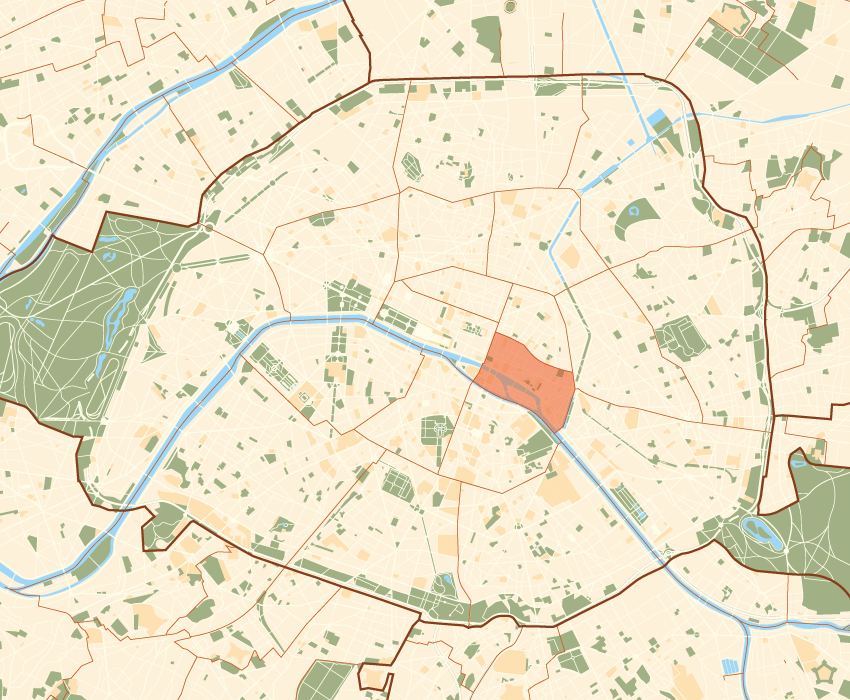- 4th arrondissement of Paris
French municipal arrondissement
arrondissementnumber=4th
commune=Paris
caption=Notre-Dame, on theÎle de la Cité in the 4th arrondissement.
mapcaption=Paris and its closest suburbs
lat_long=
région=Île-de-France
département=Paris
maire=Dominique Bertinotti
alt mini=|alt maxi=
km²=1.60
sans=
28,600
30,675
date-sans=July 1, 2005 estimate)
(March 8, 1999 census|dens=17,864|date-dens=2005|The 4th arrondissement of Paris is one of the 20 arrondissements (administrative districts) of the capital city of
France .Situated on the
Right Bank of theRiver Seine , it is bordered to the west by the 1st arrondissement; to the north by the 3rd, to the east by the 11th and 12th, and to the south by the Seine and the 5th.The 4th arrondissement contains the
Renaissance -era Paris City Hall. It also contains the Renaissance square ofPlace des Vosges , the overtly modern Pompidou Centre and the southern lively part of the medieval district ofLe Marais , which today is known for being the gay district of Paris (while the northern more quiet part of Le Marais is contained inside the 3rd arrondissement). The eastern parts of theÎle de la Cité (includingNotre-Dame de Paris ) as well as theÎle Saint-Louis are also included within the 4th arrondissement.Geography
With a land area of 1.601 km² (0.618 sq.miles, or 396 acres), the 4th arrondissement is the third smallest arrondissement in the city.
Demographics
The peak of population of the 4th arrondissement actually occurred before 1861, though the arrondissement has existed in its current shape only since the re-organization of Paris in 1860. In 1999, the population was 30,675, while the arrondissement hosted 41,424 jobs.
Historical population
¹The peak of population actually occurred before 1861, but theYear
(of French censuses)Population Density
(inh. per km²)1861 (peak of population)¹108,520 67,783 1872 95,003 59,377 1954 70,944 41,638 1962 61,670 38,520 1968 54,029 33,747 1975 40,466 25,275 1982 33,990 21,230 1990 32,226 20,129 1999 30,675 19,160 2005 28,600 17,864
arrondissement was created in 1860, so we do not have figures before 1861.Immigration
France immigration
collectivity_name=the 4th arrondissement
census_year=1999
metropolitan_France=78.1
outside_metropolitan_France=21.9
overseas_France=0.7
foreign_French=4.8
EU-15=5.6
non-EU-15=10.8History
The Île de la Cité has been inhabited since the
1st century BC , when it was occupied by theParisii tribe of theGauls . TheRight Bank was first settled in the earlyMiddle Ages (exactly: In the 5th century). Since the end of the19th century ,le Marais has been populated by a significantJewish population, the Rue des Rosiers being at the heart of its community, with a handful ofkosher restaurants. Since the 1990s,gay culture has made an impact on the arrondissement, opening a number of bars and cafés in the area by the town hall.Map
Cityscape
Places of interest in the arrondissement
*
Bazar de l'Hôtel de Ville department store
*Berthillon
*Bibliothèque de l'Arsenal
*Centre Georges Pompidou
*Hôtel-Dieu hospital
*Hôtel de Sens
*Hôtel de Sully , on the site of a former "orangery "
* Hôtel de Ville
*Le Marais
*Rue des Rosiers
*Lycée Charlemagne
*Musée de l'Assistance Publique - Hôpitaux de Paris
*Musée Boleslas Biegas ,Musée Adam Mickiewicz , andSalon Frédéric Chopin
*Musée de la Magie
*Notre-Dame de Paris
*Pavillon de l'Arsenal
*Prefecture of Police
*Saint-Jacques Tower
*St-Gervais-et-St-Protais Church
*Saint-Louis-en-l'Île Church
*Salle des Traditions de la Garde Républicaine
* Former Temple, fortress and later prison
*Temple du Marais Main streets and squares
*
Place de la Bastille (shared with the 11th and 12th arrondissements), including theJuly Column ("Colonne de juillet")
*Place de l'Hôtel de Ville , formerlyPlace de Grève
*Rue de Rivoli (shared with the 1st arrondissement)
*Place des Vosges (shared with the 3rd arrondissement)External links
*wikitravel|Paris/4th arrondissement
Wikimedia Foundation. 2010.
